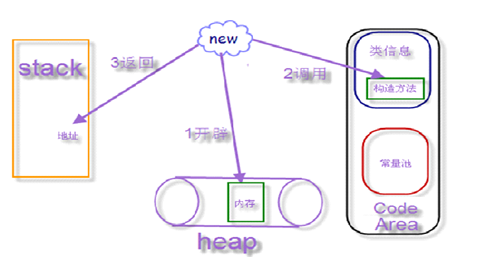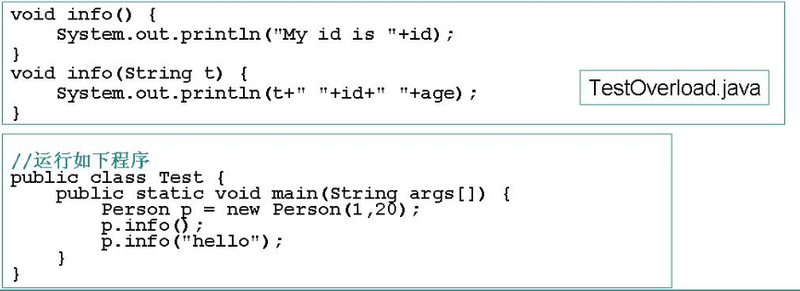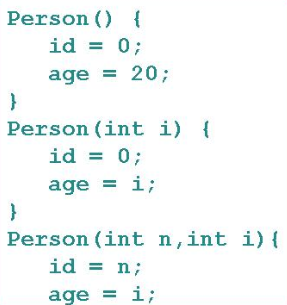乐字节Java构造器(构造方法|构造函数)、方法与内存分析
一、 构造器(构造方法|构造函数)
在创建对象时(new),必会调用一个特殊的方法,这个方法是初始化对象信息的为new服务的。这个方法称为“构造器”

使用 new + 构造方法创建一个新的对象。
构造函数是定义在 Java类中的一个用来初始化对象的函数。
构造函数与类同名且没有返回值。
例如: Person类的构造函数:
public class Person {
int id;
int age;
Person(int n, int i){
id = n;
age = i;
}
}
创建对象时,使用构造函数初始化对象的成员变量
public class Test {
public static void main(String[] args) {
Person tom = new Person(1, 18);
Person jeck = new Person(2, 20);
}
}
二、构造方法的特点:
1) 名称必须和类名一致,与类名相同
2) 没有返回类型|void
3) 构造器可以存在return,return有选择的跳出构造器
4) 不能随便调用,和new在一起使用,其他时候不能调用
5) 修饰符不能为 final abstract static
作用:
初始化对象信息,不是用于创建对象的
空构造:
没有参数的构造器、无参构造
1) 一个类中,如果没有显示|手动 加入 任意构造器 javac编译后 自动加入空构造
2) 一旦加入构造器, javac 不会加入空构造器
三、方法的重载
方法的重载是指一个类中可以定义有相同的方法名,但参数不同的多个方法。调用时,会根据不同的参数列表选择对应的方法。

四、构造方法的重载
与普通方法一样,构造方法也可以重载
例子如下:

五、 引用与内存分析
A:一个对象的内存图
B:二个对象的内存图
C:三个对象的内存图
内存分析
划分

引用的特点:
1) 同一时刻一个一引用只能指向一个对象
2) 一个对象可以被多个引用所指向,其中一个对其进行更改,该对象的其他引用也可见该变化
3) Java一切为值传递,引用拷贝地址
约定俗成的命名规则
类名的首字母大写
变量名和方法名的首字母小写
运用驼峰标识
例子:
public class Cat {
String color; // 毛的颜色
String name; // 名称
public void chase(Mice mice){
mice.type = "jerry"; // 改变
System.out.println(name + " 逮 " + mice.type);
}
public static void main(String[] args) {
// 引用 与内存分析(运行期为--》数据的流向)
Cat cat = new Cat();
cat = new Cat();
// 引用发生变化,同一个时刻一个引用只能指向一个对象
cat.color = "黑色";
cat.name = "tom";
Mice mice = new Mice();
mice.type = "米奇";
// 将二者联系起来 --》 依赖
cat.chase(mice);
// 传递时,值拷贝,拷贝地址,拷贝完成后 一个对象被多个引用所指向
System.out.println(mice.type);
// jerry 其中一个对其发生变化,该对象的其他引用也可减该变化
}
}
class Mice{
String type;
}
定义如下类
public class BirthDate {
int day;
int month;
int year;
public BirthDate(int d, int m, int y){
day = d;
month = m;
year = y;
}
void setDay(int d){
day = d;
}
void setMonth(int m){
month = m;
}
void setYear(int y){
year = y;
}
int getDay(){
return day;
}
int getMonth(){
return month;
}
int getYear(){
return year;
}
void display(){
System.out.println(day + "-" + month + "-" + year);
}
}
测试类:
public class Test {
public static void main(String[] args) {
Test test = new Test();
int date = 9;
BirthDate d1 = new BirthDate(7,7,1970);
BirthDate d2 = new BirthDate(1,1,2000);
test.change1(date);
test.change2(d1);
test.change3(d2);
System.out.println(date);
System.out.println(d1);
System.out.println(d2);
}
void change1(int i){
i = 1234;
}
void change2(BirthDate b){
b = new BirthDate(22,2,2004);
}
void change3(BirthDate b){
b.setDay(22);
}
}
总结:
对象的创建和使用,必须使用new 关键字创建对象,使用对象引用.成员变量来引用对象的成员变量,使用对象引用.方法(参数列表)来调用对象的方法。
同一类的每个对象有不同的成员变量存储空间,同一类的每个对象共享该类的方法,
非静态方法是针对每个对象进行调用 。
乐字节原创,转载请注明出处。请继续关注乐字节











![[HBLOG]公众号](https://www.liuhaihua.cn/img/qrcode_gzh.jpg)

